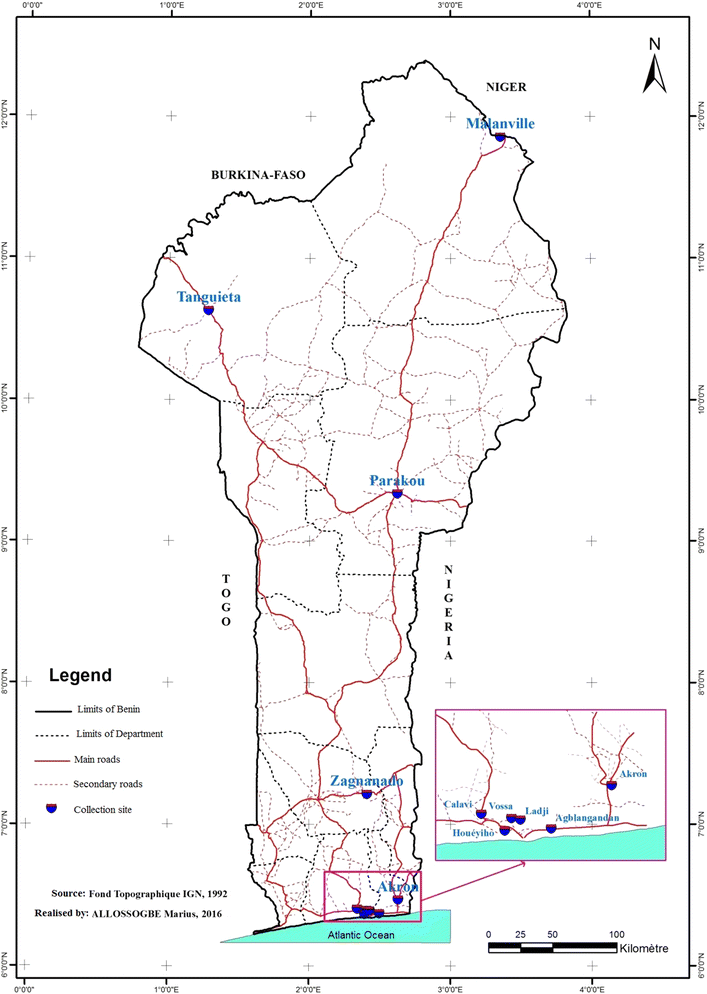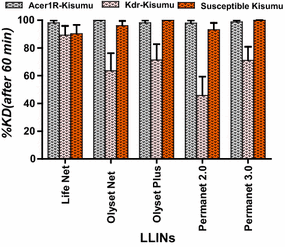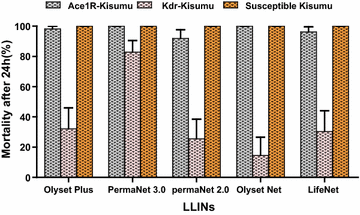WHO cone bio-assays of classical and new-generation long-lasting insecticidal nets call for innovative insecticides targeting the knock-down resistance mechanism in Benin
- PMID: 28202024
- PMCID: PMC5312429
- DOI: 10.1186/s12936-017-1727-x
WHO cone bio-assays of classical and new-generation long-lasting insecticidal nets call for innovative insecticides targeting the knock-down resistance mechanism in Benin
Abstract
Background: To increase the effectiveness of insecticide-treated nets (ITN) in areas of high resistance, new long-lasting insecticidal nets (LLINs) called new-generation nets have been developed. These nets are treated with the piperonyl butoxide (PBO) synergist which inhibit the action of detoxification enzymes. The effectiveness of the new-generation nets has been proven in some studies, but their specific effect on mosquitoes carrying detoxification enzymes and those carrying both detoxification enzymes and the knock-down resistance gene in Benin is not well known. Thus, the objective of this study is to evaluate the efficacy of LLINs treated with PBO on multi-resistant Anopheles gambiae s.l.
Methods: The study occurred in seven cities in Benin, Abomey, Cotonou, Porto-Novo, Zangnanado, Parakou, Malanville and Tanguiéta, and included ten locations selected on a north-south transect. Mosquito larvae were collected from these sites, and adult females from these larvae were exposed to single-pyrethroid-treated nets (LifeNet, PermaNet 2.0, Olyset Net) and bi-treated nets (PermaNet 3.0 and Olyset Plus) based on their level of resistance and using WHO cone tests following WHO guidelines.
Results: The different LLINs showed 100% mortality of the susceptible laboratory strain Kisumu and the resistant strain Ace-1R Kisumu. However, with the resistant laboratory strain kdr-Kisumu, mortality was low (16-32%) for all LLINs except PermaNet 3.0 (82.9%). The mortality of local strains carrying only the kdr mechanism varied from 0 to 47% for the single-pyrethroid-treated LLINs and 9 to 86% for bi-treated LLINs. With local strains carrying several mechanisms of resistance (kdr + detoxification enzymes), the observed mortality with different LLINs was also low except for PermaNet 3.0, which induced significantly higher mortality, usually greater than 75% (p < 0.001), with multi-resistant strains. The inhibition of the mortalities induced by the LLINs (11-96%) on multi-resistant field populations was similar to the inhibition observed with the laboratory strain carrying only the knock-down resistance mechanism (kdr-Kisumu) (p > 0.05).
Conclusion: This study showed that the new-generation LLINs treated with pyrethroids and PBO showed better efficacy compared to conventional LLINs. Although the addition of PBO significantly increased the mortality of mosquitoes, the significant role of the kdr resistance gene in the low efficacy of LLINs calls for LLIN technology innovation that specifically targets this mechanism.
Keywords: Bio-efficacy; LLINs; Piperonyl butoxide; Resistant mosquitoes.
Figures
References
-
- WHO. World malaria report 2015. Geneva: World Health Organization; 2015. http://www.who.int/malaria/publications/world-malaria-report-2015/report.... Accessed 15 Aug 2016.
-
- WHO. The Abuja declaration and the plan of action. An extract from the African Summit on Roll Back Malaria. Geneva: World Health Organization; 2003; p. 1–11. http://www.who.int/malaria/publications/atoz/whocdsrbm200346/en/. Accessed 15 Aug 2016.
-
- Carnevale P, Robert V, Boudin C, Halna JM, Pazart L, Gazin P, et al. Control of malaria using mosquito nets impregnated with pyrethroids in Burkina Faso. Bull Soc Path Exot Filiales. 1988;81:832–846. - PubMed
-
- Desfontaine M, Gelas H, Cabon H, Goghomou A, Kouka Bemba D, Carnevale P. Evaluation des pratiques et des couts de lutte antivectorielle à l’échelon familial en Afrique Centrale. II. Ville de Douala (Cameroun), juillet 1988. Ann Soc Belge Méd Trop. 1990;70:137–144. - PubMed
MeSH terms
Substances
LinkOut - more resources
Full Text Sources
Other Literature Sources
Miscellaneous




